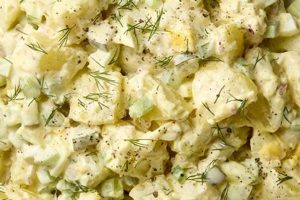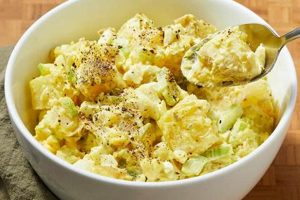A classic side dish reimagined for dietary restrictions and personal preferences, this variation omits eggs while retaining the creamy, savory essence of traditional potato salad. Typically, it involves cooked potatoes combined with other vegetables, herbs, and a flavorful dressing. A simple example might include potatoes, celery, onion, and a dressing of mustard, vinegar, and plant-based mayonnaise.
This egg-free approach broadens accessibility, catering to individuals with egg allergies or sensitivities. It also offers a lighter alternative, often reducing the overall cholesterol and fat content. Historically, variations on potato salad likely predate widespread refrigeration, and eggless versions may have been more common due to the perishability of eggs. This highlights the adaptability of the dish and its enduring appeal across culinary traditions.
The following sections will delve into specific ingredient choices, preparation techniques, and serving suggestions for crafting a delicious and satisfying eggless potato salad.
Tips for Crafting Exceptional Eggless Potato Salad
Achieving a flavorful and satisfying eggless potato salad requires careful consideration of ingredient selection and preparation techniques. These tips offer guidance for creating a dish that rivals traditional versions.
Tip 1: Potato Selection Matters: Opt for waxy potatoes like Yukon Gold or red potatoes. These varieties hold their shape well during cooking and contribute a creamy texture.
Tip 2: Precise Cooking Technique: Cook potatoes until tender but not mushy. Slightly undercooked potatoes will result in a firmer salad. Overcooked potatoes will create a gummy texture.
Tip 3: Enhance Flavor with Aromatics: Incorporating finely diced celery, red onion, or bell peppers adds complexity and depth of flavor.
Tip 4: Crafting a Creamy Dressing: Plant-based mayonnaise or a combination of mashed avocado and vegan yogurt can create a rich and satisfying dressing.
Tip 5: The Power of Seasoning: Fresh herbs like dill, parsley, or chives provide brightness. Mustard, both Dijon and yellow, adds tanginess. A touch of celery seed or paprika enhances the overall flavor profile.
Tip 6: Balance is Key: Careful balancing of acidity and sweetness is essential. Vinegar or lemon juice provides necessary acidity. A touch of agave or maple syrup can add subtle sweetness without overpowering other flavors.
Tip 7: Rest and Chill: Allowing the salad to rest in the refrigerator for at least an hour allows the flavors to meld, creating a more harmonious and flavorful experience.
By following these tips, one can create an eggless potato salad that delivers exceptional flavor, texture, and visual appeal. Proper technique and ingredient selection ensure a satisfying culinary experience.
With these guidelines in place, a deeper exploration into variations and customization possibilities follows.
1. Potato Variety
Potato selection significantly influences the texture and overall success of an egg-free potato salad. Choosing the appropriate variety is crucial for achieving the desired outcome, impacting both the structural integrity of the salad and its ability to absorb flavors from the dressing and other ingredients.
- Waxy Potatoes:
Waxy potatoes, such as Yukon Gold and red potatoes, are ideal for potato salad. Their low starch content allows them to hold their shape after cooking, preventing a mushy texture. Their creamy consistency complements the richness of the dressing. In an egg-free context, this firm texture becomes even more critical as the egg’s binding properties are absent.
- Starchy Potatoes:
Russet or Idaho potatoes, categorized as starchy potatoes, are less suitable. Their high starch content results in a fluffier texture that tends to break down when mixed with other ingredients. This can lead to a less appealing, disintegrated salad, especially without egg to bind the ingredients.
- All-Purpose Potatoes:
Varieties like white potatoes fall into an intermediate category. While not as firm as waxy potatoes, they can be used with careful attention to cooking time. Slightly undercooking helps them retain some structure. However, in eggless potato salad, they might still contribute to a slightly softer consistency compared to waxy options.
- Impact on Flavor Absorption:
The potato’s density also affects flavor absorption. Denser, waxy potatoes absorb the dressing and seasonings more evenly, contributing to a well-balanced flavor profile. Starchy potatoes, due to their fluffier texture, might not absorb the flavors as effectively, potentially leading to uneven seasoning distribution within the salad.
Therefore, careful consideration of potato variety is essential when preparing egg-free potato salad. Opting for waxy potatoes contributes significantly to the salad’s structural integrity and ensures a creamy texture that complements the other ingredients and dressing, compensating for the absence of egg.
2. Dressing
The dressing is a pivotal component of egg-free potato salad, contributing significantly to its overall flavor profile, texture, and appeal. In the absence of eggs, which traditionally provide richness and binding, the dressing assumes an even greater role in creating a cohesive and satisfying dish. The choice of dressing ingredients and their careful balance determine the final character of the salad, influencing its creaminess, tanginess, sweetness, and overall sensory experience.
- Creaminess:
Replicating the creamy texture typically provided by eggs requires alternative ingredients within the dressing. Plant-based mayonnaise offers a convenient and effective solution. Mashed avocado contributes both creaminess and a subtle, buttery flavor. Vegan yogurt, particularly cashew-based varieties, offers a tangy creaminess. These options provide the desired richness while aligning with the egg-free nature of the recipe.
- Tanginess and Acidity:
Balancing the richness of the creamy base with acidity is essential for a well-rounded flavor profile. Vinegar, particularly apple cider vinegar or white wine vinegar, provides a classic tang. Lemon juice offers a brighter, citrusy acidity. The level of acidity should complement the other flavors without overpowering them. Achieving this balance is key to a palatable and refreshing potato salad.
- Sweetness:
A touch of sweetness can enhance the overall flavor complexity and balance the tanginess of the dressing. Agave nectar or maple syrup provides subtle sweetness without overpowering the other ingredients. Granulated sugar can also be used but should be added sparingly to avoid excessive sweetness. The goal is to achieve a harmonious blend of flavors, where sweetness complements the other taste components.
- Flavor Enhancers:
Beyond the core elements of creaminess, acidity, and sweetness, additional ingredients can enhance the dressing’s flavor profile. Mustard, both Dijon and yellow, adds a pungent depth. Finely chopped fresh herbs like dill, parsley, or chives contribute brightness and freshness. Spices like celery seed, paprika, or onion powder introduce subtle nuances. These additions contribute complexity and depth, elevating the potato salad beyond a simple combination of ingredients.
Careful consideration of these facets within the dressing is crucial for crafting a successful egg-free potato salad. The interplay of creamy elements, acidity, sweetness, and flavor enhancers creates a cohesive and flavorful dressing that compensates for the absence of eggs while contributing a distinct and satisfying character to the dish.
3. Ingredients
Ingredient selection significantly impacts the flavor profile, texture, and overall quality of egg-free potato salad. A thoughtful combination of components creates a balanced and satisfying dish that compensates for the absence of eggs. The interplay of starches, vegetables, herbs, and spices contributes to the complexity and depth of flavor, while also influencing the salad’s textural appeal.
Potatoes, the foundational ingredient, require careful consideration. Waxy varieties like Yukon Gold maintain their structure during cooking, preventing a mushy texture. The inclusion of other vegetables, such as celery, red onion, and bell peppers, introduces contrasting textures and flavors, adding depth and complexity. Fresh herbs like dill, parsley, or chives impart brightness, while spices like celery seed or paprika contribute subtle warmth and earthiness. The choice of dressing ingredients further influences the final outcome. Plant-based mayonnaise provides a creamy base, while mustard adds tanginess. A touch of sweetness from agave or maple syrup balances the acidity from vinegar or lemon juice. For example, a combination of Yukon Gold potatoes, celery, red onion, dill, and a Dijon mustard-based dressing creates a vibrant and flavorful salad.
Strategic ingredient selection is essential for achieving a successful egg-free potato salad. The careful balance of flavors and textures contributes to a satisfying culinary experience. Understanding the role of each ingredient allows for informed choices, resulting in a dish that stands on its own merit, even without the traditional binding and richness provided by eggs.
4. Preparation Method
Preparation methods significantly influence the final quality and flavor profile of egg-free potato salad. Proper techniques ensure optimal texture, prevent ingredient degradation, and maximize flavor development. Understanding these methods is crucial for achieving a successful outcome, especially in the absence of eggs, which traditionally contribute to binding and richness.
- Potato Cooking:
Cooking potatoes to the correct degree of doneness is essential. Overcooking leads to a mushy texture, while undercooking results in a firm, potentially unpleasant bite. Potatoes should be cooked until tender but not falling apart. This can be achieved by boiling, steaming, or roasting, with each method imparting subtle differences in texture and flavor. For egg-free potato salad, maintaining the structural integrity of the potatoes is particularly important, as the absence of egg necessitates a firmer potato texture to prevent the salad from becoming overly soft.
- Cooling and Drying:
After cooking, allowing the potatoes to cool completely before adding the dressing prevents the dressing from breaking down and becoming watery. Excess moisture can also dilute the flavors. Thoroughly drying the potatoes after cooking further enhances the ability of the potatoes to absorb the dressing, ensuring even flavor distribution throughout the salad.
- Dressing Incorporation:
Gently folding the dressing into the cooled potatoes prevents the potatoes from breaking down. Overmixing can lead to a mushy, less appealing texture. Adding the dressing while the potatoes are still slightly warm can enhance flavor absorption but requires careful attention to temperature to avoid a watery dressing. In an egg-free version, this gentle handling is crucial for maintaining the desired texture and preventing the salad from becoming overly soft.
- Chilling and Resting:
Chilling the potato salad for at least an hour before serving allows the flavors to meld and develop fully. This resting period allows the potatoes to absorb the dressing and seasonings, resulting in a more cohesive and flavorful salad. The chilling process also firms the salad, enhancing its textural appeal.
These preparation methods are interconnected and contribute collectively to the overall success of egg-free potato salad. Careful attention to each step, from potato cooking to chilling and resting, ensures optimal texture, flavor development, and a satisfying culinary experience. Mastering these techniques is particularly important when omitting eggs, as they compensate for the binding and richness that eggs traditionally provide.
5. Flavor Balance
Flavor balance is paramount in egg-free potato salad, impacting overall palatability and satisfaction. Eggs, often present in traditional recipes, contribute inherent richness and subtle savory notes. Their absence necessitates careful balancing of other flavor components to achieve a comparable complexity and prevent the salad from tasting bland or unbalanced. A harmonious blend of creamy, tangy, salty, and subtly sweet elements is key. Consider a scenario where the dressing relies solely on plant-based mayonnaise. Without sufficient acidity from vinegar or lemon juice, the salad can become overly rich and cloying. Conversely, excessive acidity without a balancing sweetness or creamy element can result in a sharp, unappetizing flavor profile. The interplay of these elements is crucial.
Achieving this balance requires a nuanced approach to ingredient selection and proportion. The inherent sweetness of certain potato varieties, such as Yukon Gold, influences the need for added sweetness in the dressing. The tanginess of mustard contributes to overall acidity, reducing the amount of vinegar required. The saltiness of ingredients like pickles or olives needs consideration when seasoning with additional salt. For instance, if using a briny pickle relish, one might reduce the added salt to prevent excessive saltiness. Conversely, a milder pickle might require a touch more salt in the dressing to achieve the desired savory balance. Dill, with its bright herbaceous notes, can balance the richness of a plant-based mayonnaise-based dressing. Understanding these interactions is critical for creating a well-rounded flavor profile.
In conclusion, successful egg-free potato salad hinges on meticulous flavor balancing. Careful consideration of each ingredient’s contribution, whether creamy, tangy, salty, or sweet, allows for precise adjustments to achieve a harmonious and satisfying result. This careful orchestration of flavors compensates for the absence of eggs, ensuring the final product offers a complex and enjoyable culinary experience.
Frequently Asked Questions
This section addresses common inquiries regarding egg-free potato salad preparation, offering practical solutions and clarifying potential misconceptions.
Question 1: What can be used as an egg replacement for binding in egg-free potato salad?
While eggs traditionally act as a binder, their function in potato salad is less critical than in other dishes like mayonnaise. Egg-free versions often rely on the inherent starchiness of the potatoes and the creamy texture of the dressing to create a cohesive mixture. Overmixing should be avoided as it can lead to a gummy texture.
Question 2: How can one prevent egg-free potato salad from becoming watery?
Wateriness often results from excess moisture introduced during cooking or from the dressing. Ensuring potatoes are thoroughly dried after cooking helps mitigate this issue. Cooling potatoes completely before adding the dressing prevents the dressing from thinning out due to residual heat. Selecting waxy potatoes helps retain their shape and minimize moisture release.
Question 3: What are the best potato varieties for egg-free potato salad?
Waxy potatoes like Yukon Gold and red potatoes are ideal. Their lower starch content allows them to hold their shape well after cooking, resulting in a firmer, less mushy salad. This firmness is particularly desirable in egg-free versions, where the absence of egg’s binding properties can make the salad more prone to disintegration.
Question 4: Can egg-free potato salad be made ahead of time?
Yes, preparing egg-free potato salad in advance is often advantageous. Chilling for at least an hour, or even overnight, allows the flavors to meld, resulting in a more harmonious final product. This also allows the salad to firm up, enhancing its texture.
Question 5: How can one adjust the tanginess of egg-free potato salad?
Tanginess is primarily controlled by the amount of vinegar or lemon juice in the dressing. Start with a smaller amount and gradually add more to taste, ensuring the tang complements the other flavors without overpowering them. Ingredients like pickles or pickle relish also contribute to tanginess and should be considered when adjusting the overall acidity.
Question 6: How should leftover egg-free potato salad be stored?
Store leftover egg-free potato salad in an airtight container in the refrigerator for up to three days. Keeping the salad chilled prevents bacterial growth and maintains its quality. Consume within this timeframe for optimal flavor and food safety.
Understanding these points provides a comprehensive foundation for creating and enjoying high-quality, egg-free potato salad.
Additional resources and recipe variations can be explored in the following sections.
Eggless Potato Salad
Exploration of egg-free potato salad reveals a versatile and adaptable dish. Careful consideration of potato variety, dressing composition, complementary ingredients, preparation techniques, and flavor balance yields a satisfying culinary experience. Waxy potatoes maintain structural integrity, while thoughtfully crafted dressings, incorporating plant-based mayonnaise, yogurt, or avocado, provide creaminess and depth. Strategic inclusion of vegetables, herbs, and spices adds complexity and textural contrast. Proper cooking, cooling, and chilling methods ensure optimal flavor development and prevent undesirable outcomes like wateriness or mushiness. Precise balancing of tangy, sweet, and savory elements within the dressing creates a harmonious flavor profile.
This exploration demonstrates that eliminating eggs does not diminish the potential for creating a delicious and satisfying potato salad. Rather, it presents an opportunity for culinary creativity and adaptation, catering to dietary restrictions while expanding the possibilities of this classic dish. Further exploration and experimentation with diverse ingredients and flavor combinations promise continued evolution and enjoyment of egg-free potato salad.






